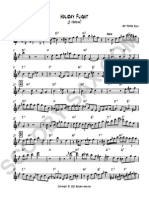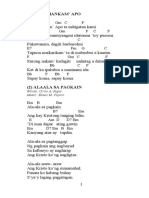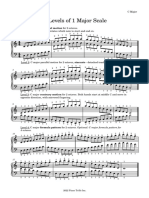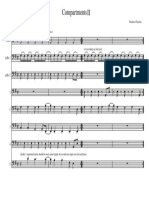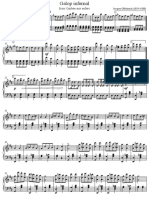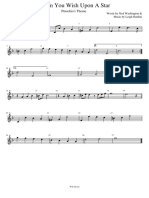School of Ragtime - Scott Joplin - Sheet Music
School of Ragtime - Scott Joplin - Sheet Music
Uploaded by
PublicDomainSheetsCopyright:
Available Formats
School of Ragtime - Scott Joplin - Sheet Music
School of Ragtime - Scott Joplin - Sheet Music
Uploaded by
PublicDomainSheetsOriginal Title
Copyright
Available Formats
Share this document
Did you find this document useful?
Is this content inappropriate?
Copyright:
Available Formats
School of Ragtime - Scott Joplin - Sheet Music
School of Ragtime - Scott Joplin - Sheet Music
Uploaded by
PublicDomainSheetsCopyright:
Available Formats
SCHOOL
OF RAGTIME
BY
SCOTT JOPLIN
Composer of “Maple Leaf Rag.”
REMARKS- What is scurrilously called ragtime is an invention that is here to stay. That is now conceded
by all classes of musicians. That all publications masquerading under the name of ragtime are not the genuine
article will be better known when these exercises are studied. That real ragtime of the higher class is
rather difficult to play is a painful truth which most pianists have discovered. Syncopations are no
indication of light or trashy music, and to shy bricks at “hateful ragtime” no longer passes for musical
culture. To assist amateur players in giving the “Joplin Rags” that weird and intoxicating effect intended
by the composer is the object of this work.
Exercise No.1.
It is evident that, by giving each note its proper time and by scrupulously observing the ties, you will
get the effect. So many are careless in these respects that we will specify each feature. In this num-
ber, strike the first note and hold it through the time belonging to the second note. The upper staff is
not syncopated, and is not to be played. The perpendicular dotted lines running from the syncopated note
below to the two notes above will show exactly its duration. Play slowly until you catch the swing, and
24
never play ragtime fast at any time.
Slow march tempo (Count Two)
24
42
Exercise No.2.
This style is rather more difficult, especially for those who are careless with the left hand, and are
prone to vamp. The first note should be given the full length of three sixteenths, and no more. The sec-
ond note is struck in its proper place and the third note is not struck but is joined with the second as
though they were one note. This treatment is continued to the end of the exercise.
2
4
Slow march tempo (Count Two)
2
4
42
School of Ragtime Public Domain 1/3
Exercise No.3.
This style is very effective when neatly played. If you have observed the object of the dotted lines they will
lead you to a proper rendering of this number and you will find it interesting.
2
4
Slow march tempo (Count Two)
2
4
2
4
Exercise No.4.
The fourth and fifth notes here form one tone, and also in the middle of the second measure and so to
the end. You will observe that it is a syncopation only when the tied notes are on the same degree of the
24
staff. Slurs indicate a legato movement.
Slow march tempo (Count Two)
24
42
Exercise No.5.
The first ragtime effect here is the second note, right hand, but, instead of a tie, it is an eighth note :
rather than two sixteenths with tie. In the last part of this measure, the tie is used because the tone is
24
carried across the bar. This is a pretty style and not as difficult as it seems on first trial.
Slow march tempo (Count Two)
2
4
42
School of Ragtime Public Domain 2/3
2
4
5
24
2
4
Exercise No.6.
The instructions given, together with the dotted lines, will enable you to interpret this variety which
has very pleasing effects. We wish to say here, that the “Joplin ragtime” is destroyed by careless or im-
perfect rendering, and very often good players lose the effect entirely, by playing too fast. They are
harmonized with the supposition that each note will be played as it is written, as it takes this and
also the proper time divisions to complete the sense intended.
2
4
Slow march tempo (Count Two)
2
4
42
2
4
5
2
4
2
4
School of Ragtime Public Domain 3/3
You might also like
- Dorothy (Dr. John Version) - C Major - MN0204935Document11 pagesDorothy (Dr. John Version) - C Major - MN0204935Sam Rebello100% (1)
- River Deep Mountain HighDocument15 pagesRiver Deep Mountain HighIne Rico100% (1)
- Battle Hymn of The RepublicDocument2 pagesBattle Hymn of The RepublicMatthias StruckenNo ratings yet
- Amar Pelos Dois Voice With Piano Accompaniment Portuguese English Translation PDFDocument3 pagesAmar Pelos Dois Voice With Piano Accompaniment Portuguese English Translation PDFEduardo SilvaNo ratings yet
- Holiday Flight - Key of C - Art Pepper TranscriptionDocument2 pagesHoliday Flight - Key of C - Art Pepper TranscriptionjonnythejazzNo ratings yet
- New York New York For Jazz Combo-DrumsDocument2 pagesNew York New York For Jazz Combo-DrumsRafaelBastosOliveiraNo ratings yet
- Neworleans Piano Styles Huey Piano SmithDocument3 pagesNeworleans Piano Styles Huey Piano SmithCTB100% (1)
- Claus For Concern - 5e Holiday Oneshot - 1.1Document22 pagesClaus For Concern - 5e Holiday Oneshot - 1.1Andy BerezovskiyNo ratings yet
- 12 Major Scales2 PDFDocument1 page12 Major Scales2 PDFYuval Lev AriNo ratings yet
- Magic WaltzDocument7 pagesMagic WaltzGingerNo ratings yet
- Kimi no na wa 君の名は。: Zen Zen ZenseDocument6 pagesKimi no na wa 君の名は。: Zen Zen ZensebelNo ratings yet
- GCSE AS and A Level Music Difficulty Levels Booklet PDFDocument378 pagesGCSE AS and A Level Music Difficulty Levels Booklet PDFCris Sousa0% (1)
- The Fives Original Sheet MusicDocument3 pagesThe Fives Original Sheet MusicPublicDomainSheets100% (1)
- Waltz Op. 69 No. 2 - Urtext Edition - Frédéric Chopin - Sheet MusicDocument3 pagesWaltz Op. 69 No. 2 - Urtext Edition - Frédéric Chopin - Sheet MusicPublicDomainSheetsNo ratings yet
- Acts SongbookDocument141 pagesActs SongbookSenpai Aldrin100% (2)
- La Mesha - Kenny Dorham BB C EbDocument3 pagesLa Mesha - Kenny Dorham BB C EbMatthiasBergmannNo ratings yet
- Evolution of Drum Corps Drumming Summer1980Document16 pagesEvolution of Drum Corps Drumming Summer1980Indigo Machado100% (2)
- Jazz Piano Studies PDFDocument5 pagesJazz Piano Studies PDFCres J-Jireh100% (2)
- FW03563 PDFDocument10 pagesFW03563 PDFNovia Damayanti100% (1)
- Storia - D'amore - MSCZ - FisarmonicaDocument2 pagesStoria - D'amore - MSCZ - FisarmonicaEnzo Dell'AiraNo ratings yet
- Afternoon in Paris - BB PDFDocument1 pageAfternoon in Paris - BB PDFRobert Noguera100% (1)
- 7 Levels of 1 Major ScaleDocument2 pages7 Levels of 1 Major ScaleStefano FerrantiNo ratings yet
- Icebreaker: Solo Für DrumsDocument1 pageIcebreaker: Solo Für DrumsВладимир ЦейтлинNo ratings yet
- 1.crazy Rhythm PianoDocument6 pages1.crazy Rhythm PianomateuszNo ratings yet
- Bill Evans From Left..Document2 pagesBill Evans From Left..stellamastoraki1049No ratings yet
- April SkyDocument4 pagesApril SkyalekstrjazzNo ratings yet
- Flats Sharps WorksheetDocument1 pageFlats Sharps WorksheetJustinLaNo ratings yet
- Jordan Rudess Technique (Advanced)Document1 pageJordan Rudess Technique (Advanced)Emmanuel SanchezNo ratings yet
- La Pompe: The Technique: Step 1Document4 pagesLa Pompe: The Technique: Step 1miguel4444555No ratings yet
- Ted Reed - Drums Latin Rhytms - 1-1Document1 pageTed Reed - Drums Latin Rhytms - 1-1Всему Миру МирNo ratings yet
- Esperando: Emaj Gmaj Amaj DmajDocument1 pageEsperando: Emaj Gmaj Amaj DmajAntoniousBlockNo ratings yet
- Keith Jarrett - Koeln Concert (Preface)Document5 pagesKeith Jarrett - Koeln Concert (Preface)Josecalle2013100% (1)
- LuizaDocument2 pagesLuizamarcosmjazzNo ratings yet
- Kurenai PDFDocument3 pagesKurenai PDFmoronidanNo ratings yet
- Trumpet G4 Music ScoreDocument14 pagesTrumpet G4 Music Scorealvarogc_207923No ratings yet
- Dil Hai Chotasa With Chords For RDocument1 pageDil Hai Chotasa With Chords For Rjebaraj sNo ratings yet
- Be Encouraged Kiefer's SoloDocument2 pagesBe Encouraged Kiefer's SoloVittorio Pagano100% (1)
- Gertrude's Bounce: Max Roach SoloDocument1 pageGertrude's Bounce: Max Roach SoloAntonio NinniNo ratings yet
- Donald Gray Scales Arpegios For PianoDocument15 pagesDonald Gray Scales Arpegios For PianoFRANCISCO MANUEL AHUMADANo ratings yet
- Asbestos by Fats Waller Sheet MusicDocument2 pagesAsbestos by Fats Waller Sheet MusicHociungGeorgeNo ratings yet
- Night TrainDocument2 pagesNight TrainastolfolacosteNo ratings yet
- Green Chimney - Solo Wynton Marsalis - Por Acsel CopqueDocument2 pagesGreen Chimney - Solo Wynton Marsalis - Por Acsel CopqueAcsel Copque100% (1)
- Lvrite Counting. You Can Count You Can Play Beat: in Rememberl Sixteenth NotesDocument11 pagesLvrite Counting. You Can Count You Can Play Beat: in Rememberl Sixteenth NoteserchamoNo ratings yet
- Gettin' ThereDocument2 pagesGettin' ThereRo BertNo ratings yet
- New York New York For Jazz Combo-Trombone 1Document1 pageNew York New York For Jazz Combo-Trombone 1RafaelBastosOliveiraNo ratings yet
- Blues Harmonica Beginner (Lesson 4)Document2 pagesBlues Harmonica Beginner (Lesson 4)DeimNo ratings yet
- Undercover TranscriptionDocument1 pageUndercover TranscriptionTom Van de VoordeNo ratings yet
- Leekonitz-All The Things You Are-SoloDocument7 pagesLeekonitz-All The Things You Are-Solopippo9318No ratings yet
- F Blues Scale (Solo Example Level 1,2,3)Document1 pageF Blues Scale (Solo Example Level 1,2,3)Pamai ChirdkiatisakNo ratings yet
- Feels - So - Good - Chuck - Mangione PartyturaDocument19 pagesFeels - So - Good - Chuck - Mangione PartyturaTomNo ratings yet
- Bloc Party - Helicopter (BASS Tab)Document5 pagesBloc Party - Helicopter (BASS Tab)juanidarNo ratings yet
- Albert Ammons Swanee River Boogie PDFDocument1 pageAlbert Ammons Swanee River Boogie PDFRealPassion0% (3)
- P 1Document1 pageP 1shwezin01070% (4)
- Just Friends: Klavierarangement David ZwettiDocument2 pagesJust Friends: Klavierarangement David ZwettiDavid ZwettiNo ratings yet
- Ustream Bassline Walking Bassline Dave FrankDocument3 pagesUstream Bassline Walking Bassline Dave FrankMarkPetersNo ratings yet
- Nicas Dream BelmondoDocument2 pagesNicas Dream BelmondoTobias WeberNo ratings yet
- Jazz A 2 PianosDocument1 pageJazz A 2 PianosJaume VilasecaNo ratings yet
- Diatonic Triads and Roman Numerals: K KK KKK KL L LK LkkoDocument2 pagesDiatonic Triads and Roman Numerals: K KK KKK KL L LK LkkoselfdevNo ratings yet
- Rhythm Exercises in Triplets Rhythm Exercises in Triplets: Pete Sklaroff Pete SklaroffDocument2 pagesRhythm Exercises in Triplets Rhythm Exercises in Triplets: Pete Sklaroff Pete SklaroffPete SklaroffNo ratings yet
- O Tannenbaumarranged by Vince GuaraldiDocument4 pagesO Tannenbaumarranged by Vince Guaraldiwf9pqk9kshNo ratings yet
- I Got Rhythm-PianoDocument1 pageI Got Rhythm-PianoLuisa GoenagaNo ratings yet
- Blues Licks in F: For Jazz EnsembleDocument13 pagesBlues Licks in F: For Jazz EnsembleGiorgio Ostinelli100% (1)
- School of Ragtime - Scott Joplin - 1908Document3 pagesSchool of Ragtime - Scott Joplin - 1908Sebastián Aguilera HernándezNo ratings yet
- The Planets Suite. MVT IV. Jupiter The Bringer of JollityDocument30 pagesThe Planets Suite. MVT IV. Jupiter The Bringer of JollityLaTonya Hutchison 101No ratings yet
- Thodoris Pistiolas - Compartments IIDocument1 pageThodoris Pistiolas - Compartments IINanouk BesinNo ratings yet
- Nocturne Op.9 No.2: in Eb MajorDocument4 pagesNocturne Op.9 No.2: in Eb MajorjunpinpianoNo ratings yet
- Nocturne Op. No.: AndanteDocument5 pagesNocturne Op. No.: Andanteeduardoak1984No ratings yet
- Chord Chart JQHNDocument2 pagesChord Chart JQHNPublicDomainSheetsNo ratings yet
- BEALE STREET BLUES Virginia - Edu.Document2 pagesBEALE STREET BLUES Virginia - Edu.PublicDomainSheetsNo ratings yet
- Gavotte in G: Georg Friedrich HändelDocument1 pageGavotte in G: Georg Friedrich HändelPublicDomainSheetsNo ratings yet
- FOPP3Ed Ilovepdf CompressedDocument266 pagesFOPP3Ed Ilovepdf CompressedPublicDomainSheetsNo ratings yet
- OpenScore - Tips For Transcribers ShoogleDocument6 pagesOpenScore - Tips For Transcribers ShooglePublicDomainSheetsNo ratings yet
- The Ragtime Dance - Scott Joplin - Sheet MusicDocument4 pagesThe Ragtime Dance - Scott Joplin - Sheet MusicPublicDomainSheets100% (3)
- IMSLP233634-PMLP35287-Please Say You Will HQ TypesetDocument4 pagesIMSLP233634-PMLP35287-Please Say You Will HQ TypesetPublicDomainSheetsNo ratings yet
- My BuddyDocument3 pagesMy BuddyPublicDomainSheetsNo ratings yet
- Joplin Scott When Your Hair Is Like The Snow 35108 PDFDocument5 pagesJoplin Scott When Your Hair Is Like The Snow 35108 PDFPublicDomainSheetsNo ratings yet
- Black and White Rag Album-of-Rags Winifred Atwell No1Document2 pagesBlack and White Rag Album-of-Rags Winifred Atwell No1PublicDomainSheets100% (1)
- Bass Goin Crazy-Boogie-Woogie-by-Albert-Ammons-ilovepdf-compressedDocument4 pagesBass Goin Crazy-Boogie-Woogie-by-Albert-Ammons-ilovepdf-compressedPublicDomainSheetsNo ratings yet
- Snoring Sampson.: A Quarrel in RagtimeDocument4 pagesSnoring Sampson.: A Quarrel in RagtimePublicDomainSheetsNo ratings yet
- Grace and Beauty Indian UniversityDocument4 pagesGrace and Beauty Indian UniversityPublicDomainSheetsNo ratings yet
- Little Black Baby Ilovepdf CompressedDocument4 pagesLittle Black Baby Ilovepdf CompressedPublicDomainSheetsNo ratings yet
- My BuddyDocument3 pagesMy BuddyPublicDomainSheetsNo ratings yet
- March Majestic - Scott Joplin - Sheet MusicDocument4 pagesMarch Majestic - Scott Joplin - Sheet MusicPublicDomainSheets100% (1)
- The Easy Winners - Scott Joplin - Sheet MusicDocument4 pagesThe Easy Winners - Scott Joplin - Sheet MusicPublicDomainSheets100% (3)
- Sunburst Rag by James Scott Pub.1909 Sheet MusicDocument4 pagesSunburst Rag by James Scott Pub.1909 Sheet MusicPublicDomainSheetsNo ratings yet
- Paragon Rag - Scott Joplin - Sheet MusicDocument5 pagesParagon Rag - Scott Joplin - Sheet MusicPublicDomainSheetsNo ratings yet
- The Strenuous Life - Scott Joplin - Sheet MusicDocument4 pagesThe Strenuous Life - Scott Joplin - Sheet MusicPublicDomainSheetsNo ratings yet
- Can Can From Orphée Aux Enfers Offenbach Piano Sheet MusicDocument2 pagesCan Can From Orphée Aux Enfers Offenbach Piano Sheet MusicPublicDomainSheets80% (5)
- Chopin Nocturne in B, Op. 32 No. 1 Sheet Music ABRSMDocument4 pagesChopin Nocturne in B, Op. 32 No. 1 Sheet Music ABRSMPublicDomainSheetsNo ratings yet
- The Virtuoso Pianist (Le Piano Virtuose) by Charles-Louis Hanon Exercises 1 To 30Document1 pageThe Virtuoso Pianist (Le Piano Virtuose) by Charles-Louis Hanon Exercises 1 To 30PublicDomainSheets100% (5)
- Drama GameDocument14 pagesDrama Gamerose ann armentaNo ratings yet
- More Than You Know - YouTubeDocument3 pagesMore Than You Know - YouTubeZarasyry ZaraNo ratings yet
- Examen Blanc Diplome National Du Brevet Toutes Series: Session Janvier 2016Document6 pagesExamen Blanc Diplome National Du Brevet Toutes Series: Session Janvier 2016TOURE100% (1)
- Lesson IIIDocument5 pagesLesson IIIAllyssa JhaneNo ratings yet
- Moravian Choralbuch - Manuscript BMB4 Facsimile)Document33 pagesMoravian Choralbuch - Manuscript BMB4 Facsimile)mark5009No ratings yet
- Love Your Body Teachers Guide 97807112524244030Document23 pagesLove Your Body Teachers Guide 97807112524244030hardiNo ratings yet
- Practically Perfect 11 Nov 24 11 47 26Document8 pagesPractically Perfect 11 Nov 24 11 47 26Mary BloomNo ratings yet
- Hohner Accordions Erica Fingering ChartDocument2 pagesHohner Accordions Erica Fingering ChartAuguste AngersNo ratings yet
- Go To Hell: Towards A Gesture-Based Compositional Practice: Contemporary Music ReviewDocument26 pagesGo To Hell: Towards A Gesture-Based Compositional Practice: Contemporary Music Reviewchrisg1997No ratings yet
- MAPEH 2week 3-4 Second Q.docx ReDocument4 pagesMAPEH 2week 3-4 Second Q.docx Remarisol corpuzNo ratings yet
- Holy Forever-Bethel Music-Moments - Wait.E.7Document4 pagesHoly Forever-Bethel Music-Moments - Wait.E.7Andrea ReyesNo ratings yet
- Grade 8 MUSIC Q3 - M1Document17 pagesGrade 8 MUSIC Q3 - M1Albert Ian Casuga50% (2)
- IE65 Midterm Sample Test Wwith KeyDocument9 pagesIE65 Midterm Sample Test Wwith Keylethithuy14012006No ratings yet
- All at Once (Piano)Document3 pagesAll at Once (Piano)boramyeoNo ratings yet
- Huss & Dalton Newsletter - April 2015Document8 pagesHuss & Dalton Newsletter - April 2015westsideryanNo ratings yet
- How Film and TV Music Communicate Vol.1Document334 pagesHow Film and TV Music Communicate Vol.1durmamustafa_6687140No ratings yet
- Chord Melody Songbook 7 11 18 Great C3woptDocument223 pagesChord Melody Songbook 7 11 18 Great C3woptDJPNo ratings yet
- Music7 Q4 Mod8Document22 pagesMusic7 Q4 Mod8Lalaine Bulut0% (1)
- De Tham Khao Giua HK1 Lop 8 - Q8Document20 pagesDe Tham Khao Giua HK1 Lop 8 - Q8tho32632No ratings yet
- Chris AdlerDocument7 pagesChris AdlermodimanahanNo ratings yet
- When You Wish Upon A Star-Flauta PDFDocument1 pageWhen You Wish Upon A Star-Flauta PDFHerminioJuniorNo ratings yet
- Holy Rosary Academy: of Sapang Dalaga IncDocument4 pagesHoly Rosary Academy: of Sapang Dalaga IncJuefessa June BorlingNo ratings yet
- Altas Imss Estudiantes 2024-IIDocument36 pagesAltas Imss Estudiantes 2024-IIJosé Antonio Verduzco ArceNo ratings yet
- Military Dating FormatDocument25 pagesMilitary Dating Formatlorrieann9977No ratings yet
- Mozart - Violin Concerto No.5 in A, K.219 - Partitura Completa - Full Sheet Music - Score - W.A. MozartDocument32 pagesMozart - Violin Concerto No.5 in A, K.219 - Partitura Completa - Full Sheet Music - Score - W.A. MozartBíblia CraftNo ratings yet
- Billie JeanDocument5 pagesBillie JeanAnonymous SYErujsNo ratings yet




